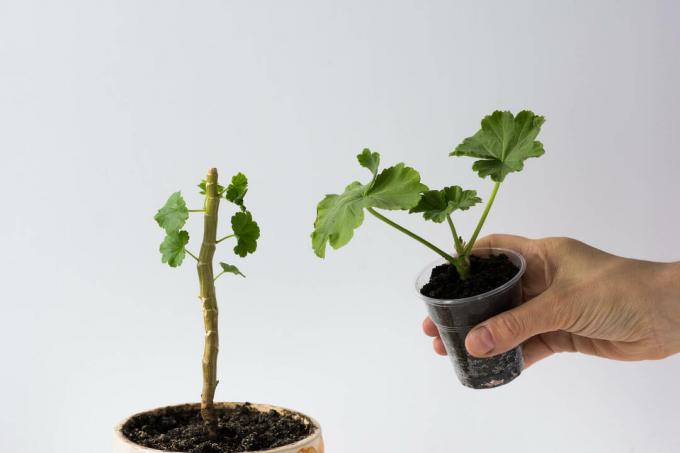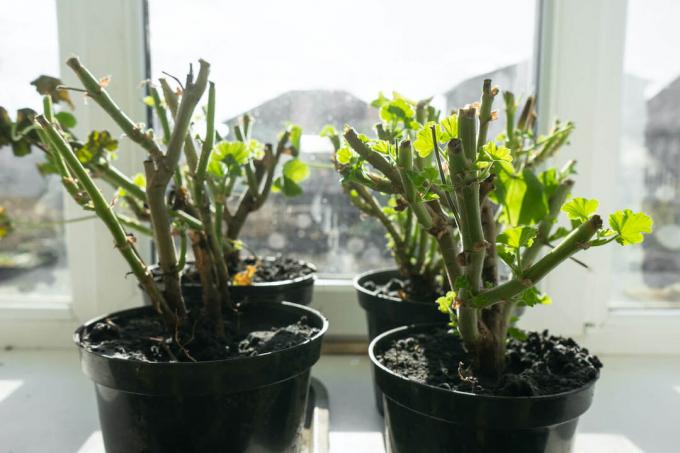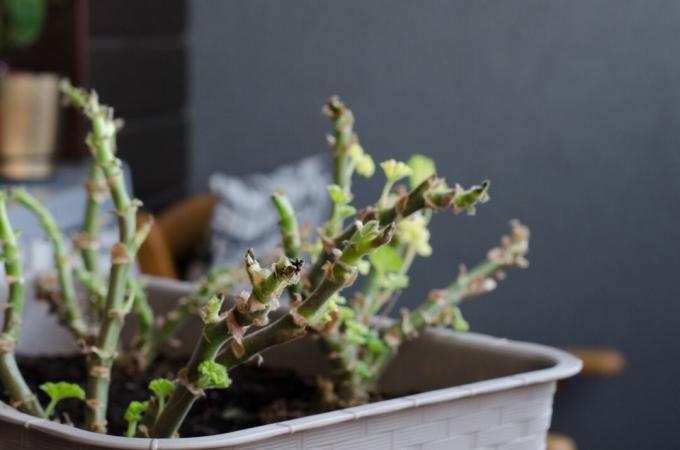So that your geraniums survive the first frost well, we have summarized everything for you to successfully overwinter, cut and care for them.
When the first frost sets in, a lot of geraniums land (Pelargonium) on the compost after a blooming summer season. The geraniums can be brought over the winter without much effort.
The term "geranium" is actually an unfavorable trivial name, as there is a genus called geranium to which the pelargoniums do not (any longer) belong. Most of the wild pelargonium (or, more popularly, geranium) species are at home in the warm regions of South Africa. So it is not really surprising that the perennial plants actually bless the temporal in winter freezing temperatures instead of experiencing a second spring. With a little preparation and the right winter quarters, you can help your favorite geraniums through the winter without much effort. Here you will find out how geraniums survive the cold season without any problems, so that your most beautiful specimens can amaze your neighbors in the next flowering phase.
contents
- Wintering geraniums: the right time
- Wintering geraniums: preparations and cutting
- Wintering geraniums: location and care
- Wintering geraniums: spring pruning after wintering
Wintering geraniums: the right time
Geraniums can also tolerate light frosts down to around -5 ° C (if they are protected). Before the first severe frost, however, the plants should be moved to their winter quarters. This is usually the case at the end of October. If you want to be on the safe side, bring your little plants to the shelter in September or early October.
Note: If the first frost hits you unexpectedly: Plants in which only the leaves and not the stem have frozen will sprout again without problems in the next year.

Wintering geraniums: preparations and cutting
In order to help your geraniums through the dark and cold winter as optimally as possible, you need a few preparations. The plants are taken from their flower boxes, beds, etc. removed and the loose soil carefully knocked off. As many fine roots as possible should remain intact. Then all shoots are reduced to approx. Trimmed 10 cm in length, leaving two to three knots per shoot. However, the woody part of the shoots is not cut back. To avoid disease and to minimize evaporation, the leaves of the geranium are removed.

What is left of your once beautifully blooming geraniums is transplanted into suitable pots or bags. The roots are covered with a mixture of sand and potting soil. Even if your once imposing eye-catcher may now look a bit battered, you don't need to worry, because new flower-rich shoots will sprout in the next year.
Summary preparation and cut:
- Remove the plants from the container and carefully remove the soil from the roots
- unwooded part of the shoots to approx. Shorten by 10 cm
- Remove leaves
- Cover the roots with sand and potting soil in a pot or bag
tip: If necessary, you can cut cuttings from the removed shoot parts and thus your Propagate geranium. You can find out how to do this in our special article.
Wintering geraniums: location and care
Now it is time to find a suitable roost for the plants. A dark and cool place like a basement is ideal for bringing the plants through the winter. Here the geranium is protected from direct sun or Protected from light. This prevents the plants from starting to sprout again too early and suffering from a lack of water.
Optionally, a bright place with around five to ten degrees Celsius (e.g. B. a winter garden or a bright stairwell) serve as winter quarters.

Another option is to spend the winter in heated places such as the living room window sill. In this cozy warmth, the geranium sprouts again. If there are too many shoots, some of the new shoots will be cut off. As a result, more side shoots are formed and the plant becomes bushier and more compact. In addition, the formation of flower buds is promoted. Some species of geraniums, in particular Pelargonium grandiflorum Hybrids, however, require a cold period of one to six weeks for flower formation.
During the winter, the geranium is kept dry and watered only occasionally. Fertilization is not necessary.
Summary of location and maintenance:
- optimal location: dark and cool (e.g. B. in the basement)
- occasionally watering; rather keep dry
- no fertilization
Wintering geraniums: spring pruning after wintering
In February or early March, the dark wintering geraniums are gently awakened from their hibernation by placing them on the windowsill and pouring them harder. Here the plants can slowly acclimate. To give the late risers the best possible start to the new season, they can be repotted in new substrate.
There is also a spring pruning. Geiltriebe may have formed during the winter in the cellar. This is usually a sign that the storage was either too warm and dark or too light but cool. These elongated, thin shoots are removed because they do not form flowers.
If new shoots have formed in the sunny winter quarters, these are also shortened. This is how beautiful, bushy new shoots emerge later.

When pruning, dry stems that are black on the inside may appear. Even if the plant does not seem to have survived the winter successfully, there is hope. It is possible that the root will sprout again anyway. All of the old wood is cut off and the roots are placed in new soil.
Summary of spring pruning after wintering:
- Acclimatization: February / beginning of March from the winter quarters onto the windowsill or similar and pour more
- Spring pruning: remove geil shoots, possibly Shorten new drives
- The plants can go outside again from mid-May
Depending on the weather (there should no longer be any risk of frost), the plants can go back outside in mid-May. How to be the best after winter Location for geraniums Find out in this post. And if you are generally for that Geranium care you can read on here.
Would you like to be always up to date and get a peek behind the scenes at Plantura? Then follow us on Instagram! There you will find daily tips and tricks about sustainable gardening and learn about exciting new products.
planturagarden
For more sustainable plant splendor 🌿
Our products come to you with ❤️
Share your little plants under #PlanturaPlants 📸













